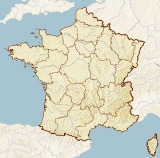
Villers-Faucon
Encyclopedia
Villers-Faucon is a commune
in the Somme
department in Picardie
in northern France
.
, at the D72 and D101 crossroads, in the far east of the département. The commune also includes the hamlet of Sainte-Emilie.
, Villers-Faucon was originally Villers-Falcon and previously Villare Falconis, which means,in Latin, villa of the hawks. Villers-Faucon’s original puprpose was that of a falconry, located in the heart of the forest of Arrouaise.
The village was almost totally destroyed in 1916, during the First World War. Following a withdrawal of German troops around the Hindenburg line
, the inhabitants were evacuated to the north to Denain
, tons of dynamite were set off around all of the buildings in the town (including the sugar refinery
at St. Emilie) and all the trees were cut down, to leave the field open for the approach of troops. The village was destroyed, but the cemetery was left untouched.
After the conflict, reconstruction began, which lasted almost a decade, led by a rebuilding cooperative led by Louis Faille
.
Communes of France
The commune is the lowest level of administrative division in the French Republic. French communes are roughly equivalent to incorporated municipalities or villages in the United States or Gemeinden in Germany...
in the Somme
Somme
Somme is a department of France, located in the north of the country and named after the Somme river. It is part of the Picardy region of France....
department in Picardie
Picardie
Picardy is one of the 27 regions of France. It is located in the northern part of France.-History:The historical province of Picardy stretched from north of Noyon to Calais, via the whole of the Somme department and the north of the Aisne department...
in northern France
France
The French Republic , The French Republic , The French Republic , (commonly known as France , is a unitary semi-presidential republic in Western Europe with several overseas territories and islands located on other continents and in the Indian, Pacific, and Atlantic oceans. Metropolitan France...
.
Geography
The commune is situated 15 miles(24 km) northwest of Saint QuentinSaint Quentin
Saint Quentin , Quintinus in Latin, also known as Quentin of Amiens, is an early Christian saint. No real details are known of his life.-Martyrdom:...
, at the D72 and D101 crossroads, in the far east of the département. The commune also includes the hamlet of Sainte-Emilie.
Population
History
According to Abbot Decagny of RoiselRoisel
Roisel is a commune in the Somme department in Picardie in northern France.-Geography:Roisel is situated northwest of Saint Quentin, on the D6 road, with the small river ‘La Cologne’ flowing through the commune.-Population:...
, Villers-Faucon was originally Villers-Falcon and previously Villare Falconis, which means,in Latin, villa of the hawks. Villers-Faucon’s original puprpose was that of a falconry, located in the heart of the forest of Arrouaise.
The village was almost totally destroyed in 1916, during the First World War. Following a withdrawal of German troops around the Hindenburg line
Hindenburg Line
The Hindenburg Line was a vast system of defences in northeastern France during World War I. It was constructed by the Germans during the winter of 1916–17. The line stretched from Lens to beyond Verdun...
, the inhabitants were evacuated to the north to Denain
Denain
It is the largest of 39 communes which comprise the association of communes of Porte du Hainaut, with a total population of 147,989, as of 1999. Denain had a population of 20,360, on a land area of 11.52 km² .-References:* -External links:...
, tons of dynamite were set off around all of the buildings in the town (including the sugar refinery
Sugar refinery
A sugar refinery is a factory which refines raw sugar.Many cane sugar mills produce raw sugar, i.e. sugar with more colour and therefore more impurities than the white sugar which is normally consumed in households and used as an ingredient in soft drinks, cookies and so forth...
at St. Emilie) and all the trees were cut down, to leave the field open for the approach of troops. The village was destroyed, but the cemetery was left untouched.
After the conflict, reconstruction began, which lasted almost a decade, led by a rebuilding cooperative led by Louis Faille
Louis Faille
Louis-Michel-Clément Faille was a French architect from Picardie. He was responsible for much reconstruction in the eastern Somme département of northern France after the end of World War I.-Professional career :...
.
Sites and monuments
- Notre Dame church was rebuilt in 1932 by architect Louis FailleLouis FailleLouis-Michel-Clément Faille was a French architect from Picardie. He was responsible for much reconstruction in the eastern Somme département of northern France after the end of World War I.-Professional career :...
. It's one of many public buildings completed by the architect in his work during the period of reconstruction of the eastern part of the Somme.

